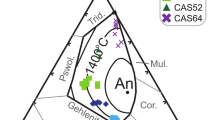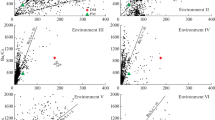Abstract
High-pressure melting experiments were performed at ~26 GPa and ~2,200–2,400°C on synthetic peridotite compositions with varying FeO and Al2O3 contents and on a synthetic CI chondrite analogue composition. Peridotite liquids show a crystallisation sequence of ferropericlase (Fp) followed down temperature by Mg-silicate perovskite (MgPv) + Fp, which contrasts a sequence of MgPv followed by MgPv + Fp observed in the chondritic composition. The difference in crystallisation sequence is a consequence of the different bulk Mg/Si ratios. MgPv/melt partition coefficients for major, minor and trace elements were determined by electron microprobe and secondary ion mass spectrometry. Partition coefficients of tri- and tetravalent elements increase with increasing Al concentration in MgPv. A lattice strain model indicates that Al3+ substitutes predominantly onto the Si-site in MgPv, whereas most elements substitute onto the Mg-site, which is consistent with a charge-compensating coupled substitution mechanism. MgPv/melt partition coefficients for Mg (DMg) and Si (DSi) are related to the melt Mg/Si ratio such that DSi becomes lower than DMg at low Mg/Si melt ratios. We use a crystal fractionation model, based on upper mantle refractory lithophile element ratios, to constrain the amount of MgPv and Ca-silicate perovskite (CaPv) that could have fractionated during a Hadean magma ocean event and could still be present as a chemically distinct heterogeneity in the lower mantle today. We show that a fractionated crystal pile composed of 96% MgPv and 4% CaPv could comprise up to 13 wt% of the entire mantle.










Similar content being viewed by others
References
Agee CB (1990) A new look at differentiation of the Earth from melting experiments on the Allende meteorite. Nature 346:834–837
Agee CB, Li J, Shannon MC, Circone S (1995) Pressure–temperature phase diagram for the Allende meteorite. J Geophys Res 100, B9:17725–17740
Akber-Knutson S, Bukowinski MST (2004) The energetics of aluminium solubility into MgSiO3 perovskite at lower mantle conditions. Earth Planet Sci Lett 220:317–330
Allan NL, Du ZM, Lavrentiev MY, Blundy JD, Purton JA, van Westrenen W (2003) Atomistic simulation of mineral-melt trace-element partitioning. Phys Earth Planet Inter 139:93–111
Allegre CJ, Poirier JP, Humler E, Hofmann AW (1995) The chemical composition of the Earth. Earth Planet Sci Lett 134:515–526
Andrault D (2003) Cation substitution in MgSiO3 perovskite. Phys Earth Planet Inter 136:67–78
Asahara Y, Kubo T, Kondo T (2004) Phase relations of a carbonaceous chondrite at lower mantle conditions. Phys Earth Planet Inter 143–144:421–432
Beattie P, Drake M, Jones J, Leeman W, Longhi J, McKay G, Nielsen R, Palme H, Shaw D, Takahashi E, Watson B (1993) Terminology for trace-element partitioning. Geochim Cosmochim Acta 57:1605–1606
Blundy JD, Wood BJ (1994) Prediction of crystal-melt partition coefficients from elastic moduli. Nature 372:452–454
Blundy JD, Falloon TJ, Wood BJ, Dalton JA (1995) Sodium partitioning between clinopyroxene and silicate melts. J Geophys Res 100 B8:15,501–15,515
Brice JC (1975) Some thermodynamic aspects of the growth of strained crystals. J Cryst Growth 28:249–253
Burns RG (1993) Mineralogical applications of crystal field theory. Cambridge University Press, Cambridge, UK, pp 551
Corgne A, Wood BJ (2002) CaSiO3 and CaTiO3 perovskite-melt partitioning of trace elements: Implications for gross mantle differentiation. Geophys Res Lett 29(19):1903, DOI: 10.1029/2001GL014398
Corgne A, Allan NL, Wood BJ (2003) Atomistic simulations of trace element incorporation into the large site of MgSiO3 and CaSiO3 perovskites. Phys Earth Planet Inter 139:113–127
Corgne A, Liebske C, Wood BJ, Frost DJ, Rubie DC (2004) Silicate perovskite-melt partitioning of trace elements and geochemical signature of a deep perovskitic reservoir. Geochim Cosmochim Acta (in press)
Drake MJ, McFarlane EA, Gasparik T, Rubie DC (1993) Mg-perovskite/silicate melt and majorite garnet/silicate melt partition coefficients in the system CaO–MgO–SiO2 at high temperatures and pressures. J Geophys Res 98(E3):5427–5431
Frost DJ, Langenhorst F (2002) The effect of Al2O3 on Fe–Mg partitioning between magnesiowüstite and magnesium silicate perovskite. Earth Planet Sci Lett 199:227–241
Frost DJ, Liebske C, Langenhorst F, McCammon CA, Tronnes RG, Rubie DC (2004) Experimental evidence for the existence of Fe-rich metal in Earth’s lower mantle. Nature 428:409–412
Gasparik T (1996) Melting experiments on the enstatite–diopside join at 70–224 kbar, including the melting of diopside. Contrib Mineral Petrol 124:139–153
Hill E, Wood BJ, Blundy JD (2000) The effect of Ca-Tschermaks component on trace element partitioning between clinopyroxene and silicate melt. Lithos 53:203–215
van der Hilst RD, Karason H (1999) Compositional heterogeneity in the bottom 1000 kilometers of Earth’s mantle: toward a hybrid convection model. Science 283:1885–1888
Hinton RW, Upton BGJ (1991) The chemistry of zircon—variations within and between large crystals from syenite and alkali basalt xenoliths. Geochim Cosmochim Acta 55:3287–3302
Hirose K, Shimizu N, van Westrenen W, Fei Y (2004) Trace element partitioning in Earth’s lower mantle and implications for geochemical consequences of partial melting at the core–mantle boundary. Phys Earth Planet Inter 146:249–260
Hofmann AW (1988) Chemical differentiation of the Earth: the relationship between mantle, continental crust, and oceanic crust. Earth Planet Sci Lett 90:297–314
Ito E, Kubo A, Katsura T, Walter MJ (2004) Melting experiments of mantle materials under lower mantle conditions with implications for magma ocean differentiation. Phys Earth Planet Inter 143–144:397–406
Kato T, Ringwood AE, Irifune T (1988a) Experimental determination of element partitioning between silicate perovskites, garnets and liquids: constraints on early differentiation in the mantle. Earth Planet Sci Lett 89:123–145
Kato T, Ringwood AE, Irifune T (1988b) Constraints on element partition coefficients between MgSiO3 perovskite and liquid determined by direct measurements. Earth Planet Sci Lett 90:65–68
Kato T, Ohtani E, Ito Y, Onuma K (1996) Element partitioning between silicate perovskite and calcic ultrabasic melt. Phys Earth Planet Inter 96:201–207
Kellogg LH, Hager BH, van der Hilst RD (1999) Compositional stratification in the deep mantle. Science 283:1881–1884
Kröger FA, Vink HJ (1956) Relation between the concentration of imperfections in crystalline solids. Solid State Phys 3:307–435
Lauterbach S, McCammon CA, van Aken P, Langenhorst F, Seifert F (2000) Mössbauer and ELNES spectroscopy of (Mg,Fe)(Si,Al)O3 perovskite: a highly oxidised component of the lower mantle. Contrib Mineral Petrol 138:17–26
McCammon C (1997) Perovskite as a possible sink for ferric iron in the lower mantle. Nature 387:694–696
McDonough WF, Sun S-s (1995) The composition of the Earth. Chem Geol 120:223–253
McFarlane EA, Drake MJ, Rubie DC (1994) Element partitioning between Mg-perovskite, magnesiowüstite, and silicate melt at conditions of the Earth’s mantle. Geochim Cosmochim Acta 58:5161–5172
Murakami M, Hirose K, Kawamura K, Sata N, Ohishi Y (2004) Post-perovskite phase transition in MgSiO3. Science 304:855–858
O’Neill SC, Palme H (1998) Composition of the silicate Earth: implication for accretion and core formation. In: Jackson I (ed) The earth’s mantle: compositions, structure, and evolution. Cambridge University Press, Cambridge, UK, pp 3–182
Presnall DC, Weng YH, Milholland CS, Walter MJ (1998) Liquidus phase relations in the system MgO–MgSiO3 at pressures up to 25 GPa—constraints on crystallisation of molten Hadean mantle. Phys Earth Planet Inter 107:83–95
Richmond NC, Brodholt JP (1998) Calculated role of aluminum in the incorporation of ferric iron into magnesium silicate perovskite. Am Mineral 83:947–951
Ringwood AE (1979) Origin of the Earth and Moon. Springer, Berlin Heidelberg New York, p 295
Salters VJM, Stracke A (2004) Composition of the depleted mantle. Geochem Geophys Geosyst 5:Q05004, DOI:10.1029/2003GC000597
Shannon RD (1976) Revised effective ionic radii and systematic studies of interatomic distances in halides and chalcogenides. Acta Crystallogr A 32:751–767
Stebbins JF, Kroeker S, Andrault D (2001) The mechanism of solution of aluminum oxide in MgSiO3 perovskite. Geophys Res Lett 28:615–618
Taura H, Yurimoto H, Kato T, Sueno S (2001) Trace element partitioning between silicate perovskites and ultracalic melt. Phys Earth Planet Inter 124:25–32
Tonks WB, Melosh HJ (1993) Magma ocean formation due to giant impacts. J Geophys Res 98 (E3):5319–5333
Trønnes RG (2000) Melting relations and major element partitioning in an oxidized bulk Earth model composition at 15–26 GPa. Lithos 53:233–245
Trønnes RG, Frost DJ (2002) Peridotite melting and mineral-melt partitioning of major and minor elements at 22–24.5 GPa. Earth Planet Sci Lett 197:117–131
Walter MJ, Nakamura E, Trønnes R, Frost DJ (2004) Experimental constraints on crystallization differentiation in a deep magma ocean. Geochim Cosmochim Acta 68:4267–4284
van Westrenen W, Wood BJ, Blundy JD (2001) A predictive thermodynamic model of garnet-melt trace element partitioning. Contrib Mineral Petrol 142:219–234
Wood BJ, Blundy JD (1997) A predictive model for rare earth element partitioning between clinopyroxene and anhydrous silicate melt. Contrib Mineral Petrol 129:166–181
Wood BJ, Rubie DC (1996) The effect of alumina on phase transformations at the 660-kilometer discontinuity from Fe–Mg partitioning experiments. Science 273:1522–1524
Yamamoto T, Yuen DA, Ebisuzaki T (2003) Substitution mechanism of Al ion in MgSiO3 perovskite under high pressure conditions from first-principles calculations. Earth Planet Sci Lett 206:617–625
Zhang J, Herzberg C (1994) Melting experiments on anhydrous peridotite KLB-1 from 5.0 to 22.5 GPa. J Geophys Res 99 (B9):17729–17742
Acknowledgements
We would like to thank Heinz Fischer, Hubert Schulze, Georg Herrmannsdörfer and Detlef Krausse for technical support. We greatly acknowledge assistance during ion microprobe analysis by R. W. Hinton and J. Craven at University of Edinburgh. C.L. is grateful for support by the German Science Foundation (DFG, project, Fr 1555/01). A.C. acknowledges receipt of a Postgraduate Scholarship from the University of Bristol. We would like to thank Reidar Trønnes and Wim van Westrenen for very helpful and constructive reviews.
Author information
Authors and Affiliations
Corresponding author
Additional information
W. Schreyer
Rights and permissions
About this article
Cite this article
Liebske, C., Corgne, A., Frost, D.J. et al. Compositional effects on element partitioning between Mg-silicate perovskite and silicate melts. Contrib Mineral Petrol 149, 113–128 (2005). https://doi.org/10.1007/s00410-004-0641-8
Received:
Accepted:
Published:
Issue Date:
DOI: https://doi.org/10.1007/s00410-004-0641-8




